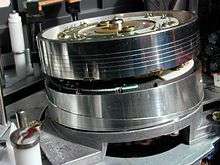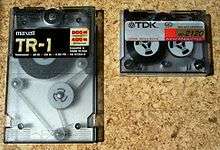Magnetic tape
Magnetic tape is a medium for magnetic recording, made of a thin, magnetizable coating on a long, narrow strip of plastic film. It was developed in Germany in 1928, based on magnetic wire recording. Devices that record and playback audio and video using magnetic tape are tape recorders and video tape recorders respectively. A device that stores computer data on magnetic tape is known as a tape drive.

Magnetic tape revolutionized sound recording and reproduction and broadcasting. It allowed radio, which had always been broadcast live, to be recorded for later or repeated airing. It allowed gramophone records to be recorded in multiple parts, which were then mixed and edited with tolerable loss in quality. It was a key technology in early computer development, allowing unparalleled amounts of data to be mechanically created, stored for long periods, and rapidly accessed.
In recent decades, other technologies have been developed that can perform the functions of magnetic tape. In many cases, these technologies have replaced tape. Despite this, innovation in the technology continues, and Sony and IBM continue to produce new magnetic tape drives.[1] Linear Tape-Open is a magnetic tape-based medium used in computer systems for data backup, since it provides large capacities at a low cost, and works differently than common hard drives or solid-state drives, reducing the chance of it failing due to similar reasons.
Over time, magnetic tape made in the 1970s and 1980s can suffer from a type of deterioration called sticky-shed syndrome. It is caused by hydrolysis of the binder in the tape and can render the tape unusable.[2]
Construction
The oxide side of a tape is the surface that can be magnetically manipulated by a tape head. This is the side that stores the information, the opposite side is simply a substrate to give the tape strength and flexibility. The name originates from the fact that the magnetic side of most tapes is typically made of iron oxide, though chromium is used for some tapes. An adhesive binder between the oxide and the substrate holds the two sides together.
In all tape formats, a tape drive uses motors to wind the tape from one reel to another, passing over tape heads to read, write or erase as it moves.
Audio recording

Magnetic tape was invented for recording sound by Fritz Pfleumer in 1928 in Germany, based on the invention of magnetic wire recording by Oberlin Smith in 1888 and Valdemar Poulsen in 1898. Pfleumer's invention used a ferric oxide (Fe
2O
3) powder coating on a long strip of paper. This invention was further developed by the German electronics company AEG, which manufactured the recording machines and BASF, at the time a division of IG Farben, which manufactured the tape. In 1933, working for AEG, Eduard Schuller developed the ring-shaped tape head. Previous head designs were needle-shaped and tended to shred the tape. Another important discovery made in this period was the technique of AC biasing, which improved the fidelity of the recorded audio signal by increasing the effective linearity of the recording medium.
Due to the escalating political tensions, and the outbreak of World War II, these developments in Germany were largely kept secret. Although the Allies knew from their monitoring of Nazi radio broadcasts that the Germans had some new form of recording technology, its nature was not discovered until the Allies acquired German recording equipment as they invaded Europe at the end of the war.[3] It was only after the war that Americans, particularly Jack Mullin, John Herbert Orr, and Richard H. Ranger, were able to bring this technology out of Germany and develop it into commercially viable formats. Bing Crosby, an early adopter of the technology, made a large investment in the tape hardware manufacturer Ampex.[4]
A wide variety of audio tape recorders and formats have been developed since, most significantly reel-to-reel and Compact Cassette.
Digital recording to flash memory and hard disk has largely supplanted magnetic tape for most purposes. However tape as a verb and as a noun has remained the common parlance for the recording process.
Some magnetic tape-based formats include:
- Stereo-Pak
- 8-track tape
- Cassette tape (officially Compact Cassette)
- Mini-Cassette
- Microcassette
- Picocassette
- NT (cassette)
- Digital Audio Tape
- Digital Compact Cassette
Video recording
The practice of recording and editing audio using magnetic tape rapidly established itself as an obvious improvement over previous methods. Many saw the potential of making the same improvements in recording the video signals used by television. Video signals use more bandwidth than audio signals. Existing audio tape recorders could not practically capture a video signal. Many set to work on resolving this problem. Jack Mullin (working for Bing Crosby) and the BBC both created crude working systems that involved moving the tape across a fixed tape head at very high speeds. Neither system saw much use. It was the team at Ampex, led by Charles Ginsburg, that made the breakthrough of using a spinning recording head and normal tape speeds to achieve a very high head-to-tape speed that could record and reproduce the high bandwidth signals of video. The Ampex system was called Quadruplex and used 2-inch-wide (51 mm) tape, mounted on reels like audio tape, which wrote the signal in what is now called transverse scan.

Later improvements by other companies, particularly Sony, led to the development of helical scan and the enclosure of the tape reels in an easy-to-handle videocassette cartridge. Nearly all modern videotape systems use helical scan and cartridges. Videocassette recorders used to be common in homes and television production facilities, but many functions of the VCR have been replaced with more modern technology. Since the advent of digital video and computerized video processing, optical disc media and digital video recorders can now perform the same role as videotape. These devices also offer improvements like random access to any scene in the recording and the ability to pause a live program and have replaced videotape in many situations.
Some magnetic tape-based formats are listed below:
- Quadruplex videotape
- Type A videotape
- Type B videotape
- Type C videotape
- U-matic
- Video Cassette Recording
- Cartrivision
- VHS
- Video 2000
- V-Cord
- VX (videocassette format)
- Betamax
- Compact Video Cassette
- Betacam
- Betacam SP
- Digital Betacam
- Betacam SX
- MPEG IMX
- HDCAM
- HDCAM SR
- M (videocassette format)
- MII (videocassette format)
- D-1 (Sony)
- DCT (videocassette format)
- D-2 (video)
- D-3 (video)
- D5 HD
- D6 HDTV VTR
- Video8
- Hi8
- Digital8
- DV
- MicroMV
Data storage

Magnetic tape was first used to record computer data in 1951 on the Eckert-Mauchly UNIVAC I. The system's UNISERVO I tape drive used a thin strip of one half inch (12.65 mm) wide metal, consisting of nickel-plated bronze (called Vicalloy). Recording density was 100 characters per inch (39.37 characters/cm) on eight tracks.[5]
Early IBM 7 track tape drives were floor-standing and used vacuum columns to mechanically buffer long U-shaped loops of tape. The two tape reels visibly fed tape through the columns, intermittently spinning 10.5 inch open reels in rapid, unsynchronized bursts, resulting in visually striking action. Stock shots of such vacuum-column tape drives in motion were widely used to represent mainframe computers in movies and television.

Most modern magnetic tape systems use reels that are much smaller than the 10.5 inch open reels and are fixed inside a cartridge to protect the tape and facilitate handling. Many late 1970s and early 1980s home computers used Compact Cassettes, encoded with the Kansas City standard, or alternate encodings. Modern cartridge formats include LTO, DLT, and DAT/DDC.
Tape remains a viable alternative to disk in some situations due to its lower cost per bit. This is a large advantage when dealing with large amounts of data. Though the areal density of tape is lower than for disk drives, the available surface area on a tape is far greater. The highest capacity tape media are generally on the same order as the largest available disk drives (about 5 TB in 2011). Tape has historically offered enough advantage in cost over disk storage to make it a viable product, particularly for backup, where media removability is necessary.
Tape has the benefit of a comparatively long duration during which the media can be guaranteed to retain the data stored on the media. Fifteen (15) to thirty (30) years of archival data storage is cited by manufacturers of modern data tape such as Linear Tape-Open media.
In 2002, Imation received a US$11.9 million grant from the U.S. National Institute of Standards and Technology for research into increasing the data capacity of magnetic tape.[6]
In 2014, Sony and IBM announced that they had been able to record 148 gigabits per square inch with magnetic tape media developed using a new vacuum thin-film forming technology able to form extremely fine crystal particles, allowing true tape capacity of 185 TB.[1][7]
References
- "Sony develops magnetic tape technology with the world's highest*1 areal recording density of 148 Gb/in2". Sony Global. Archived from the original on 5 May 2014. Retrieved 4 May 2014.
- "Magnetic Materials" (PDF). MEMORY OF THE WORLD: Safeguarding the Documentary Heritage. A guide to Standards, Recommended Practices and Reference Literature Related to the Preservation of Documents of All Kinds. UNESCO. 1998. CII.98/WS/4. Retrieved 12 December 2017.
- "BBC World Service - The Documentary Podcast, A History of Music and Technology: Sound Recording". BBC. Archived from the original on 1 July 2019. Retrieved 1 July 2019.
- Fenster, J.M. (Fall 1994). "How Bing Crosby Brought You Audiotape". Invention & Technology. Archived from the original on 4 April 2011.
- Welsh, H. F. & Lukoff, H (1952). "The Uniservo - Tape Reader and Recorder" (PDF). American Federation of Information Processing Societies. Archived (PDF) from the original on 25 February 2015. Retrieved 21 January 2019. Cite journal requires
|journal=(help) - "The Future of Tape: Containing the Information Explosion" (PDF). Archived (PDF) from the original on 13 December 2017. Retrieved 12 December 2017.
- Fingas, Jon (4 May 2014). "Sony's 185TB data tape puts your hard drive to shame". Engadget. Archived from the original on 3 May 2014. Retrieved 4 May 2014.
This article is based on material taken from the Free On-line Dictionary of Computing prior to 1 November 2008 and incorporated under the "relicensing" terms of the GFDL, version 1.3 or later.
External links
| Wikimedia Commons has media related to: |